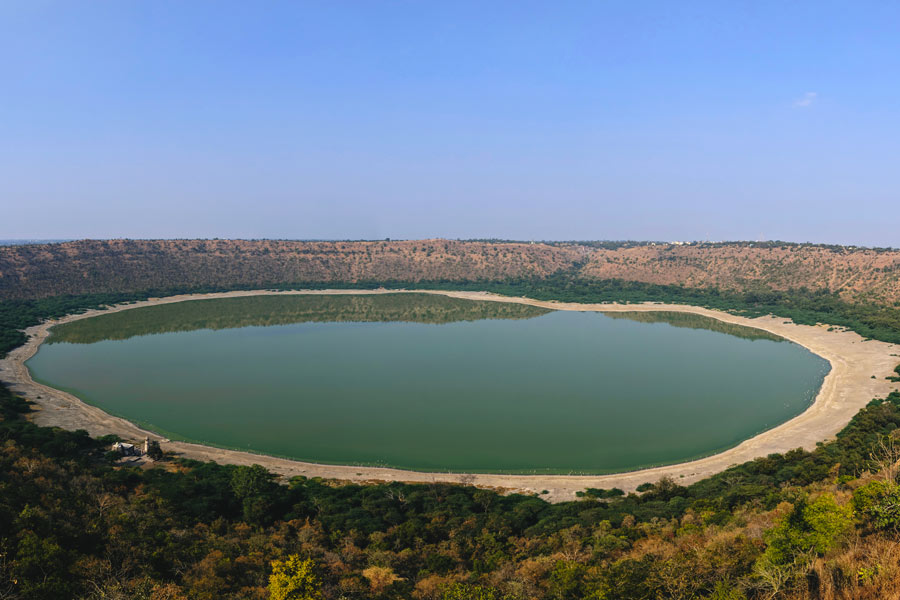The Maharashtra government plans to submit a proposal to the Archaeological Survey of India (ASI) to include the famous Lonar Lake in Buldhana district in the UNESCO World Heritage Sites list, officials have said.
The move aims to elevate the site as a global hub for tourism and research, besides boosting its conservation, they said.
Amravati Divisional Commissioner Nidhi Pandey recently met officials from various departments at Lonar to discuss the proposal.
“This proposal will soon be presented, marking a significant step towards achieving recognition,” Pandey told PTI.
Buldhana District Collector Kiran Patil said the proposal is in its final stage.
"We will submit it once it is polished. Unlike other UNESCO sites, Lonar Lake presents a unique mix of several categories. It is a geographical and scientific wonder, formed from a meteor impact,” he said.
The official said the lake in Lonar, about 460 km from Mumbai, is home to several temples, some dating back over 1,200 years.
The proposal highlights the lake’s geological importance and the urgent need for conservation efforts, he said.
“We are cataloguing biodiversity, gathering data about the temples, and documenting rare findings from excavations and research on the meteor impact conducted by various scientists,” Patil said.
After reaching ASI, the proposal will undergo a detailed review before being submitted to the United Nations Educational, Scientific and Cultural Organisation.
A UNESCO tag will ensure that the lake, spread over 113 hectares, has “outstanding universal value”.
If accepted, Lonar Lake will become India’s 41st UNESCO World Heritage Site, alongside iconic places like the Ajanta and Ellora Caves, Elephanta Caves, and Mumbai’s Chhatrapati Shivaji Maharaj Terminus.
Local activist Gajanan Kharat, who advocates for the lake’s conservation, said a few senior bureaucrats are keen on supporting the UNESCO recognition for the impact crater. However, a lot is to be done.
“Despite local appeals, the government has yet to instal signboards along national highways or the Nagpur-Mumbai Samruddhi Expressway. We have been urging their installation on these roads to attract more visitors,” he said.
Kharat said the government should encourage investment in the hospitality sector to enhance tourist experiences.
Improved services would draw more visitors, creating job opportunities for locals, he said.
Collector Patil said the old residential area in Buldhana requires significant upgrades, including basic facilities like a proper bus stand. Steady progress has been made in these areas over the past few years through review meetings, said the official.
“There is another temple in Buldhana called ‘Daitya Sudan’. It features beautiful stone construction and artistic designs, making it a significant attraction for tourists primarily visiting Lonar Lake. Some encroachments around the temple have already been cleared, and we are working on repairing and widening the access road for smoother vehicle movement,” he said.
Lonar Lake, the world’s largest basaltic impact crater, was formed approximately 50,000 years ago by a high-velocity meteor strike. Its saline-alkaline waters and surrounding ecosystem have attracted extensive research from institutions such as the Smithsonian, the United States Geological Survey, and the Geological Society of India.
A government report, part of the UNESCO submission, states that the area hosts 15 ancient temples, some over 1,200 years old, blending rich cultural history with its scientific significance. This geological wonder has a diameter of more than 1.8 kilometres and a depth of 150 metres.
Ecological and archaeological preservation of the lake is increasingly urgent, officials said.
In recent years, rising water levels have submerged five temples inside the crater. The Bombay High Court’s Nagpur Bench has established a committee to oversee the protection and development of the lake.
According to official data, over 4,26,000 domestic tourists, 72 international travellers, and five researchers visited the site last year.
Amid this influx of visitors, the authorities have banned bathing in the lake and restricted construction activities in its vicinity.
Lonar Lake, also identified as a wildlife sanctuary, was declared a Ramsar site, a wetland of international importance, a few years ago.
Except for the headline, this story has not been edited by The Telegraph Online staff and has been published from a syndicated feed.











